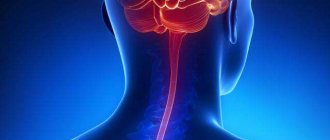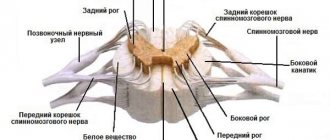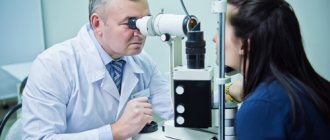Purulent meningitis is an inflammation of the soft membrane of the brain, which is caused by pyogenic microorganisms (meningococci, pneumococci, streptococci, etc.) embedded in it.
The disease can be diagnosed in all age categories of people, but most often in children under the age of five. The development of purulent meningitis is facilitated by a weakened state of the immune system, so the peak of the disease occurs in the winter-spring period.
With purulent meningitis, patients have increased body temperature, intense headache, nausea, vomiting, disorders of the cranial nerves, early appearance of meningeal syndrome, hyperesthesia, disturbance of consciousness, and psychomotor agitation.
Thanks to the development of modern medicine, today the incidence of purulent meningitis has decreased significantly, the number of severe complications and deaths has decreased.
Services for the diagnosis and treatment of meningitis are offered by the neurology clinic of the Yusupov Hospital, a leading multidisciplinary medical center in Moscow. Thanks to the modern equipment of the clinic, the impressive medical experience of our specialists and the use of the latest technologies, the Yusupov Hospital achieves high efficiency in the treatment of meningitis, including purulent meningitis.
The diagnosis of purulent meningitis in the Yusupov Hospital is based on a typical clinical picture and data from a study of cerebrospinal fluid.
For purulent meningitis, patients at the Yusupov Hospital are required to undergo antibacterial therapy. In addition, the use of decongestants, glucocorticosteroids, tranquilizers, anticonvulsants and other symptomatic treatment is prescribed.
Purulent meningitis in adults and children: causes of development
The development of purulent meningitis is caused not only by meningococcal infection, but also by pneumococci, Haemophilus influenzae and other microorganisms.
Purulent meningitis in children is often associated with infection with streptococci, salmonella, and E. coli. In accordance with the mechanism of penetration of the pathogen into the meninges, meningitis can be primary or secondary. The development of primary purulent meningitis is caused by the hematogenous spread of the pathogen from the pharynx or nasal cavity, where it enters from the outside by contact and airborne droplets.
The occurrence of secondary purulent meningitis is associated with a primary septic focus present in the patient’s body and subsequent penetration of infection into the meninges.
1.General information
The diagnosis of “otogenic meningitis” in its expanded form means “inflammation of the soft meninges caused by the spread of infection from the ear.”
Obviously, this situation is one of the most severe complications of otitis media, i.e. infectious and inflammatory processes in various receiving, sound-conducting and resonator sections of the hearing organs. The close proximity to intracranial structures, the abundance of blood vessels and lymph nodes create the prerequisites for the penetration and expansion of infection in one way or another (hematogenous, lymphogenous, contact).
Most often, children suffer from purulent otitis media (salpingootitis), and the younger the child, the higher the risk of otogenic meningitis - the reason is the infantility of the structure, incomplete anatomical formation of the sinuses and cavities in the cranial bones. Epidemiological data are contradictory (in particular, some sources associate otogenic meningitis mainly with acute, others with chronic otitis media).
A must read! Help with treatment and hospitalization!
Purulent meningitis: symptoms
The duration of the incubation period for primary purulent meningitis is, on average, from two to five days. The disease has an abrupt onset. Patients experience increased body temperature, which can reach 40°C, intense and worsening headache, severe chills, nausea and repeated vomiting. The appearance of delirium, psychomotor agitation, confusion, and convulsive syndrome may occur.
Purulent meningitis in adults and children is accompanied by specific symptoms (Brudzinsky, Kernig, Guillain, stiff neck), which occur at an early stage of the disease and intensify after 2-3 days. Patients exhibit severe hyperesthesia and decreased abdominal reflexes, while deep reflexes are increased. In some cases, a diffuse hemorrhagic rash appears.
With purulent meningitis, patients experience double vision, strabismus, drooping of the upper eyelid, and anisocoria, which is associated with damage to the oculomotor nerves.
In more rare cases, there is damage to the trigeminal nerve, the development of neuritis of the facial nerve, dysfunction of the vestibulocochlear (progressive development of hearing loss) and optic nerve (decreased visual acuity, loss of visual fields).
If the inflammatory process spreads to brain tissue, patients develop meningoencephalitis.
Clinical complex
Cephalgia, often severe and constant, occurs before other symptoms. At the initial stage, it is limited to the occipital and frontal zone, then it becomes generalized. Nausea and vomiting develop quite often. There is a prolonged fever with levels of 40°C and above. Tachycardia, however, bradycardia is also possible. The patient is in serious condition, the face is often pale, sallow in color, haggard, the surface of the tongue is dry. Confusion of consciousness, which often develops into a delusional state. The patient experiences apathy, or one can often see a motor-excited state, which intensifies under the influence of external stimuli (sound, light). The typical position of the patient is with the head thrown back and the knees bent.
There are sharply positive Kernig and Brudzinski symptoms, as well as nigidity of the occipital myogroup. In some cases, pyramidal signs are determined (patreflexes of Babinsky, Oppenheim, Gordon, etc.). It is rare to notice a convulsive condition in the arms and legs. Often, with the basal form, paralysis of the abducens, in some cases, oculomotor and other CNs is noted. In rare cases, focal brain signs appear, which force one to resort to ineffective brain puncture.
CSF is released during lumbar puncture, usually under high pressure. It is cloudy, up to purely purulent. Pleiocytosis ranges from a slight increase to a huge increase that cannot be counted. Protein levels are elevated, often significantly. Sugar and chloride levels decrease. High leukocytosis and ESR are noted.
Recently, with the widespread use of antibiotic therapy, the clinical manifestations have become weaker and the nature of the course has changed. It often occurs with low-grade fever or within normal limits, with minor pain in the head and mildly intense meningeal signs, confusion and other cerebral manifestations against the background of a general satisfactory or normal condition. The picture of the cerebrospinal fluid also changes - pleocytosis decreases, the cytopic picture transforms towards lymphocytosis, etc., the hemogram undergoes a transformation and becomes unusual for purulent leptomeningitis.
The protracted course (months) is characterized by an intermittent character. This is a relapsing form. It is due to many reasons:
- purulent foci in the labyrinth or temporal pyramid that were not removed after surgery;
- deep exodural abscesses;
- limited subarachnoid accumulations of pus, which are not amenable to treatment due to fibrinoplastic limitation of antibiotic exposure (cause focal cerebral manifestations), etc.
With such a course, with several exacerbations and extinctions, the resistance of bacteria gradually increases, in this case the prognosis is generally unfavorable. A lethal outcome is possible in the case of the hematogenous route, in which the picture often progresses at lightning speed.
Diagnosing the pathology does not present any difficulties, the only thing that needs to be found out is whether it is related to ear diseases or other intracranial complications, whether it is an epidemic cerebrospinal disease or tuberculous origin.
Purulent meningitis: consequences in adults
One of the early and serious complications of purulent meningitis is cerebral edema, as a result of which the brain stem and vital centers located in it are compressed. The development of acute cerebral edema occurs on days 2-3 of the disease, but in the fulminant form - within the first few hours.
In addition to cerebral edema, patients may experience the development of septic shock, subdural empyema, adrenal insufficiency, infective endocarditis, pneumonia, purulent arthritis, pyelonephritis, cystitis, septic panophthalmitis, etc.
4.Treatment
The treatment of choice is usually aggressive conservative treatment. One of the primary tasks is to ensure ventilation and drainage of the middle ear (through a surgical puncture in the eardrum). Prescribe broad-spectrum antibiotics in effective dosages, anti-inflammatory, antipyretic, and antipsychotic drugs according to indications. In approximately 10-20% of cases, emergency radical surgery is necessary.
Currently, deaths from otogenic meningitis have become rare, but they still occur today - as a rule, in the case of a delayed request for help, when, for example, the sluggish symptoms of chronic otitis media take on the character of “habitual” discomfort and are not associated with the patient (or parents, if we are talking about a child) with meningeal signs appearing, and the latter, in turn, are not recognized in time as brain symptoms. Also, the outcome may be unfavorable in the case of rapid development of cerebral inflammation (fulminant form of otogenic meningitis). Therefore, if the symptoms described above occur in any combination, an ambulance should be called immediately.
Purulent meningitis: diagnosis
Experienced neurologists at the Yusupov Hospital can assume the presence of purulent meningitis if the patient has meningeal syndrome and focal neurological symptoms in the form of damage to the cranial nerves.
In case of abortive course of purulent meningitis or its secondary occurrence against the background of symptoms of an existing septic focus of another localization, diagnosis is more difficult and requires a lumbar puncture with subsequent detection of increased cerebrospinal fluid pressure, its turbidity or opalescent color.
When performing a study of cerebrospinal fluid in patients with purulent meningitis, an increased level of cellular elements and protein is determined.
In order to identify the type of causative agent of the disease, the Yusupov Hospital conducts a microscopic examination of smears of cerebrospinal fluid and its inoculation on nutrient media.
During the diagnosis, a study of the discharge elements of the skin rash and a blood test are carried out.
If the secondary nature of purulent meningitis is suspected, additional studies are prescribed to determine the primary infectious focus:
- consultations with a pulmonologist, otolaryngologist, therapist and other specialists;
- otoscopy;
- X-ray of the lungs and paranasal sinuses.
During diagnosis, specialists at the Yusupov Hospital differentiate purulent meningitis from viral meningitis, subarachnoid hemorrhage, meningeal phenomena in other infections (severe forms of influenza, typhus, leptospirosis, etc.).
2. Reasons
Otogenic meningitis and/or meningoencephalitis (i.e. inflammation of the meninges, complicated by the spread of infection to the brain substance) is more often caused by bacterial pathogens, but viral etiology is also possible, usually against the background of seasonal epidemic ARVI. The leading risk factors, in addition to childhood, are general immune weakness, individual anatomical features and inadequate treatment of otitis media (or lack of such treatment). In many cases, otogenic meningitis is secondary to an otogenic brain abscess.
Visit our Otolaryngology (ENT) page
Medical complex
As a therapeutic measure, surgery on the temporal bone is used. Postoperative treatment involves massive sulfonamide and antibiotic therapy. Antibacterial therapy is combined with the prescription of nystatin to prevent the occurrence of candidiasis and vitamin treatment (vitamins B and C).
In order to reduce intracranial pressure, dehydration measures and lumbar puncture are carried out.
In severe cases, after receiving a portion of CSF, the sodium salt of penicillin is injected intralumbarally.
In particularly severe cases with a threat of increasing intracranial pressure, along with the operation performed, an opening of the lateral cerebral cistern is prescribed.
Prevention
The main role in the prevention of childhood meningitis is vaccination against the main pathogen - meningococcus and pneumococcus, as well as quarantine measures in children's institutions when purulent meningitis is detected and a complete examination of children who have been in contact with the sick person.
If possible, you should scan all foci of chronic infections in the body (chronic otitis media, carious teeth), pay attention to the general strengthening of the immune system (hardening, proper nutrition, taking vitamins), and also teach children to observe the rules of personal hygiene.
Causes
Premature babies and children with pathologies of the brain structure and those who have had intrauterine infections are considered to be the most predisposed to the occurrence of the disease.
The most common pathogens:
meningococci;- hemophilus influenzae;
- pneumococci;
- salmonella;
- spirochetes;
- ECHO viruses.
The most important factor in the development of meningitis in a child is the imperfection of the body’s defense systems - immunity is fully formed around the tenth year of life - weak intestinal microflora, which normally prevents the penetration of pathogens, as well as increased permeability of the blood-brain barrier to bacteria and their toxins.











